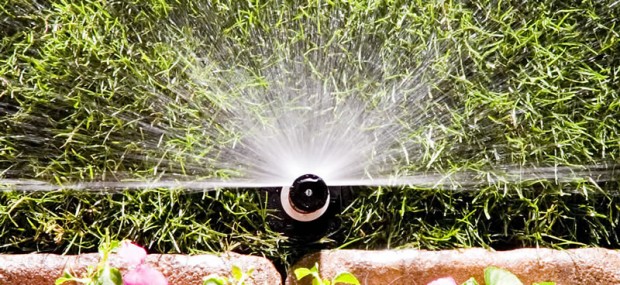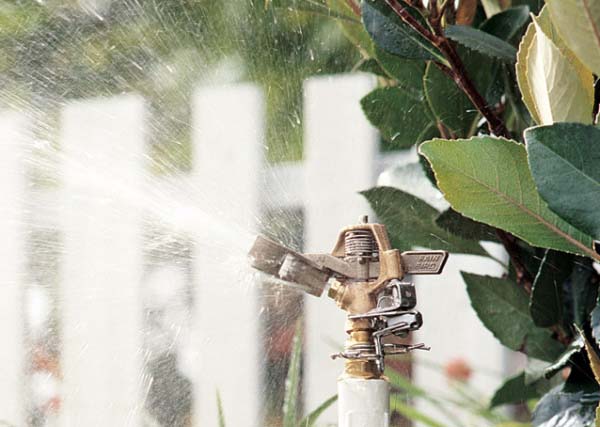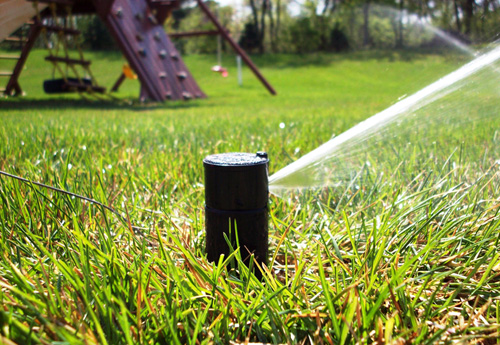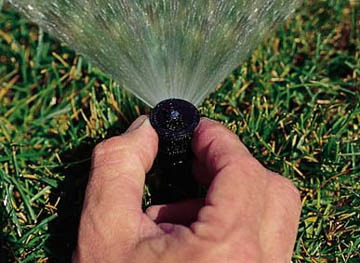“Why should I care about what ‘precipitation rate’ is?” The short answer is so you can impress all your friends at the next fancy soiree or neighborhood block party as you rattle off the difference between fixed arc pattern sprayheads and gear-drive rotors.
Precipitation rate is the amount of water put down by a sprinkler in a certain amount of time. It’s measured here in the metric system hating U.S. of A. in inches per hour (iph). The reason we care about it is because we want all of the heads on the same zone to have ‘matched’ precipitation rates.
This makes sense, right? You want an area to be evenly watered, not soggy in one spot and dry in another. Some beds or turf areas are irregular in shape, varying in distances to be covered. Varying radii of sprinkler heads are therefore required within the same zone.
A ‘zone’ is a group of heads activated by one station on the clock. This may have been obvious, but I want to make sure we’re all on the same page.
Lets talk about the two common types of sprinkler heads; sprays and rotors.
Sprayheadshave fixed pattern nozzles broken down into parts of a circle: quarters, thirds, halves, two-thirds, three-quarters, fulls. The most common radii are 8′, 10′, 12′, and 15′. There are also specialty nozzles available from most major brands with shorter radii and adjustable arcs for tricky angles. I’ll discuss some drawbacks to adjustable arc nozzles later on.
Rotors pop up and rotate in an adjusted arc, or points from which they go back and forth. The radii of rotors goes beyond that of sprays, usually 15′-60′. In the old days rotors were ‘impact heads’, the kind that people create dance moves around, and most often imitate with mouth noises: “chick, chick, chick, buhddddddddddduh.” Impact heads make us smile and think of simpler times. They were fun to run through in those summers of the ’70s as you tried to avoid stepping on beer can pull-tops in your bare feet. Nowadays they are going the way of the fanny pack and pager. You still see them around, but they’ve been largely replaced by the ‘gear drive’.
The gear drive is no fun at all. It just pops up reliably and quietly shoots a steady stream of water slowly across its arc. All of its moving parts are boringly safe inside the riser assembly, and don’t get jammed with grass and dirt. It has no interesting noise, and does not inspire one to dance.
Okay, now that we know the difference between rotors and sprays, we ask ourselves, “Could these two types of heads work together in harmony on the same zone?” The answer is: nope. They have different precipitation rates. Rotors have a much lower precip rate (I’m going to start saying ‘precip’. That’s how sprinkler guys talk). That means it takes a lot longer for a rotor to put down the same amount of water that sprayheads would in the same area. So if you have rotors covering a large section of lawn coming on with sprays covering a smaller section- one section will always be too dry or too wet, depending on the run time. That’s why well designed systems have the same type of heads on individual zones.
There are some exceptions to the rule that work in a pinch. I have personally put a sprayhead or two on a rotor zone. Usually it was because there was an irregular small piece of a bigger lawn. In this situation we have to use a spray nozzle with a low precip rate- such as a micro spray or the Toro Precision™ series which are pretty cool.
As promised earlier, we’ll discuss variable arc nozzles, or VANs. The arc (part of a circle, think of a pie wedge) can be adjusted from just a sliver of a few degrees to almost a full circle. These work good for angles less than 90 degrees, and curved edges that are a few degrees short or more than common fixed patterns. The problem with VANs is their precip rates are higher than regular nozzles. More than double in the case of an 8′ half circle. The Rainbird™ charts say their regular 8H has a flow of a half gallon per minute at 30 psi (pounds per square inch- the measurement of operating water pressure at the nozzle), and a precip rate of 1.56 iph. The 8′ VAN set to half circle at the same pressure is 1.2 gpm and 3.58 iph! This would be handy if you needed extra water in a spot, but would make it soggy if you didn’t.
Another drawback to the VAN is their intake ports inside the nozzle are tiny and easily clog. They are about the size of the mesh opening of the screens- so small debris ends up there. I’ve seen systems installed with all VANs, a rookie move by someone who wants to stock just one type of nozzle.
Now that you know all about prccip rates, iph, psi, gpm, and VANs, prepare to be the life of your next party! If guests drift away from you, its because they want to return well stocked on hors dourves to give you their full and rapt attention.






